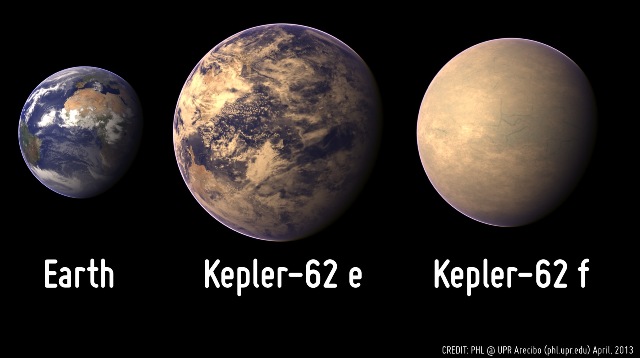Apr 19 2013
A University of Washington astronomer has discovered perhaps the most Earthlike planet yet found outside the solar system by the Kepler Space Telescope.
 The newly discovered Kepler 62e and 62f compared with the Earth. UW astronomer Eric Agol found 62f. Credit: Planetery Habitability Laboratory
The newly discovered Kepler 62e and 62f compared with the Earth. UW astronomer Eric Agol found 62f. Credit: Planetery Habitability Laboratory
Eric Agol, a UW associate professor of astronomy, has identified Kepler 62f, a small, probably rocky planet orbiting a sunlike star in the Lyra constellation. The planet is about 1.4 times the size of Earth, receives about half as much solar flux, or heat and radiation, as Earth and circles its star in 267.3 (Earth) days.
It's one of two "super-Earth" planets discovered in the star Kepler 62's habitable zone, that swath of space the right distance from the star to potentially allow liquid water to exist on a planet's surface, thus giving life a chance. A super-Earth is a planet greater in mass than our own but still smaller than gas giants such as Neptune.
Kepler 62's other super-Earth, nearby 62e, is 1.61 times Earth's size, circles the star in 122.4 days and gets about 20 percent more stellar flux than the Earth. The two are the smallest exoplanets — planets outside the solar system — yet found in a host star's habitable zone.
"The planets this small that we have found until now have been very close to their stars and much too hot to be possibly habitable. This is the first one Kepler has found in the habitable zone that satisfies this small size," Agol said. "Kepler 62f is the smallest size and the most promising distance from its star, which by these measures makes it the most similar exoplanet to Earth that has been found by Kepler."
Agol is the second author of a paper documenting the discovery published April 18 by Science Express, the online edition of the journal Science.
While the sizes of Kepler 62e and 62f are known, Agol said, their mass and densities are not — but every planet found in their size range so far has been rocky, like Earth.
"Based on its size, our best guess is that it's rocky and has some atmosphere, but not a thick gaseous envelope, like Neptune," Agol said.
The Kepler telescope was launched in 2009 with the aim of finding Earthlike planets beyond the solar system. It detects planets by "transits" that cause their host stars to appear fainter when the planets pass in front as they orbit.
Kepler 62f was a late-arrival in terms of its discovery. Its planetary siblings were found by a team of researchers led by William Borucki of the NASA Ames Research Center, principal investigator for the Kepler Space Telescope. Kepler 62 b, c and d are 1.31, 0.54 and 1.95 times the size of the Earth, respectively, but orbit the star too close to be in the habitable zone.
Borucki and some 45 co-authors were preparing to publish their findings in August 2012 when Agol contacted them that he had found an additional planet orbiting Kepler 62 that he identified in work with UW postdoctoral researcher Brian Lee.
Despite the extraordinary number of planets found by the Kepler team, they had overlooked 62f due to a sort of coincidence. Three transits are usually necessary to confirm a planet's existence, but the Kepler software recognized only two. Agol pinpointed three transits for 62f with a process developed with Lee that takes into account the slight variation of stellar brightness in the vicinity of a transit. That enabled him to confirm 62f as an actual planet — and made him a leading author of the paper.
Though the mass and densities of Kepler 62e and f are not yet known, Agol has pioneered a process called transit timing variations that may in the future show the mass of such planets by the gravitational effect they have on each other.
"This type of discovery is the reason we launched the Kepler spacecraft — to find small, Earth-sized, potentially Earth-temperature planets," Agol said. "At the same time, though, it isn't exactly the same as Earth. It is slightly larger and cooler than Earth. It tells me how special the Earth is and how it may take some time — hopefully not too long — to find its exact twin."
The work was funded by the National Science Foundation.